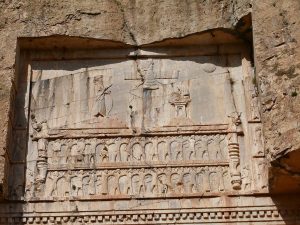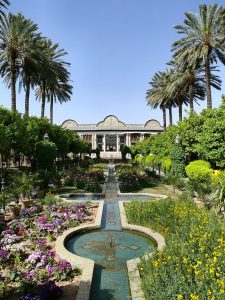
15-Day Iran Rail Tours
“A Rail Tour to Western & Central Iran”
This tour begins and ends in Tehran. You’ll get to see a beautiful country — Iran is an ancient civilization, home to no fewer than 22 UNESCO World Heritage sites.
This 15-day tour is designed for rail enthusiasts who desire first-class rail travel combined with the opportunity to see the most important historical and tourist sites of Iran.
In addition, this tour includes one of the most scenic and exciting rail routes in the Middle East – the route between Ahwaz and Dorud, in the south-west province of Khuzistan.
 The tour incorporates both rail and road travel in an ambiance of full luxury. Differing from some similar rail tours of Iran, this itinerary will include as much daytime rail travel as possible.
The tour incorporates both rail and road travel in an ambiance of full luxury. Differing from some similar rail tours of Iran, this itinerary will include as much daytime rail travel as possible.
This can be a tricky business because of the nature of Iranian train schedules. For example, not every train runs every day. When there is nighttime travel you will have your own private compartment on a top Iranian train.
Your personal guide will accompany you throughout your trip. You can travel to Iran and take this tour whenever you decide to go. Even if you are a solo traveler you will find that the tour is more affordable than many large-group tours of Iran.

Come Journey into the Heart of the “Forgotten” Persian Empire with all the Comforts of Iran’s Modern Train System
There’s no need for you to just “imagine” how wonderful traveling in Iran by rail can be. Call us today at 1-919-726-2044 or click here to request a free 30 minute travel Q&A session.
You can travel to Iran and take this tour whenever you decide to go. Even if you are a solo traveler you will find that the tour is less expensive than many large-group tours of Iran.
Pricing
- 1 person $6995
- 2 people $4695 per person
- 3-5 people $3995 per person
- 6-10 people $3495 per person
- All Prices Have Been Sharply Reduced due to Downward Movement of Iranian Currency. Call Us for Current Prices!
- IMPORTANT UPDATE: Because of the sharp slide in recent months in the value of the Iranian currency, the Rial, the prices of our tours have dropped accordingly. Please check with us about our new lower prices for all our Iran tours.
Please note: These prices are for a completely PRIVATE tour. You would NOT be part of a larger group. The prices listed above may be subject to small fluctuations due to Euro exchange rate changes. The prices above are based on shared hotel rooms and train compartments for at least two people. The single supplement for two or more people traveling together but in private accommodations is $995 per person.
About this Train Tour
You will have the chance to visit several UNESCO World Heritage sites, including, of course, the ancient city of Persepolis. 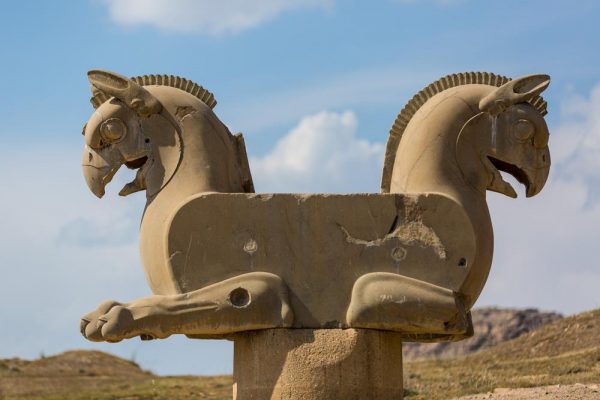 You will be traveling on the very top Iranian State Railway trains, which are very nice indeed. Meals on the train are of high quality.
You will be traveling on the very top Iranian State Railway trains, which are very nice indeed. Meals on the train are of high quality.
Here is a short Youtube video about rail travel in Iran:
Leave Any Time – All Train Tours Are Private
Interested? Call us today at 1-919-726-2044 or contact us here for a free travel Q&A session
….
 The map above shows some of the destinations and rail stretches covered by this tour. Every effort has been made to include as much daylight travel as possible so that you can take in the amazing landscape of Iran.
The map above shows some of the destinations and rail stretches covered by this tour. Every effort has been made to include as much daylight travel as possible so that you can take in the amazing landscape of Iran.
Please note: There will be some days when we will be traveling to our destinations by private vehicle. This is dictated by the Iranian train schedule. Plus there are several stops on the way that could not be seen if all travel were by train.
Detailed Itinerary of Persian Carpet Train Tour II
This is a very special tour which enables you to see the high points of tourism in Iran as well as to travel on some very interesting rail routes.
Day 1: Arrival in Tehran  You will be met at the airport and taken to the luxurious Espinas Hotel. Your program for the day will depend on what time your flight arrives. You may just want to rest up. Or you may want to be taken to see some of the attractions that Tehran has to offer. Overnight Tehran at 5-star Espinas Hotel
You will be met at the airport and taken to the luxurious Espinas Hotel. Your program for the day will depend on what time your flight arrives. You may just want to rest up. Or you may want to be taken to see some of the attractions that Tehran has to offer. Overnight Tehran at 5-star Espinas Hotel
Day 2 – Tehran This day will be devoted to seeing as much as possible in Tehran. Tehran is a large city with lots of vehicular traffic so we will have to plan the day’s itinerary carefully. You may be surprised to see snow on the northern mountainsides as late as May or even June. One must-see stop is the Golestan Palace, a UNESCO World Heritage site. This was the court and residence of the Qajar Dynasty (1794-1925). The Palace has many pools and imposing rooms, such as the Mirror Hall.
One must-see stop is the Golestan Palace, a UNESCO World Heritage site. This was the court and residence of the Qajar Dynasty (1794-1925). The Palace has many pools and imposing rooms, such as the Mirror Hall.  Tehran has too many museums to visit in the time allotted for this tour. You can discuss with your guide which museums you most want to visit and then make your choice. Among them are the National Museum, the Carpet Museum, the National Jewelry Treasury and the Glass and Ceramic Museum. You may also decide to visit a student center, where you would have the opportunity to meet with English-speaking students.
Tehran has too many museums to visit in the time allotted for this tour. You can discuss with your guide which museums you most want to visit and then make your choice. Among them are the National Museum, the Carpet Museum, the National Jewelry Treasury and the Glass and Ceramic Museum. You may also decide to visit a student center, where you would have the opportunity to meet with English-speaking students. 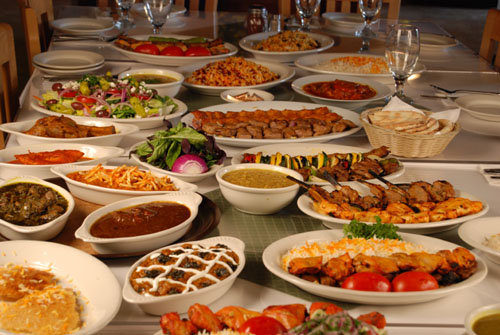 In the evening you may elect to have dinner at one of the restaurants in the foothills of Tehran, north of the city. You can also have a very nice dinner at your hotel. Or, close to the hotel, is an interesting local restaurant where you’ll see a lot of young people smoking water pipes. Overnight Espinas Hotel.
In the evening you may elect to have dinner at one of the restaurants in the foothills of Tehran, north of the city. You can also have a very nice dinner at your hotel. Or, close to the hotel, is an interesting local restaurant where you’ll see a lot of young people smoking water pipes. Overnight Espinas Hotel.
Day 3 – Tehran – Ahwaz by Rail  After a good buffet breakfast at your hotel, head for the Tehran train station and board the train departing at 12:45 PM for Ahwaz, in the South-West province of Kuzistan. We will book you your own sleeping compartment.
After a good buffet breakfast at your hotel, head for the Tehran train station and board the train departing at 12:45 PM for Ahwaz, in the South-West province of Kuzistan. We will book you your own sleeping compartment.
Day 4 – Ahwaz At around 4:30 in the morning arrive in Ahwaz and transfer to your hotel. After you get a few hours sleep your aim will be to see as much as possible in this area. There are two UNESCO World Heritage sites to be visited. One is the ancient biblical city of Susa, dating back to the 5th Century BC, where Haman the Agagite planned to annihilate the Jews of Persia. According to the Hebrew Bible, Esther outwitted him by persuading her husband, King Ahasuerus of Persia to sabotage Haman’s plan. (You will be able to visit Esther’s tomb later on in the trip). 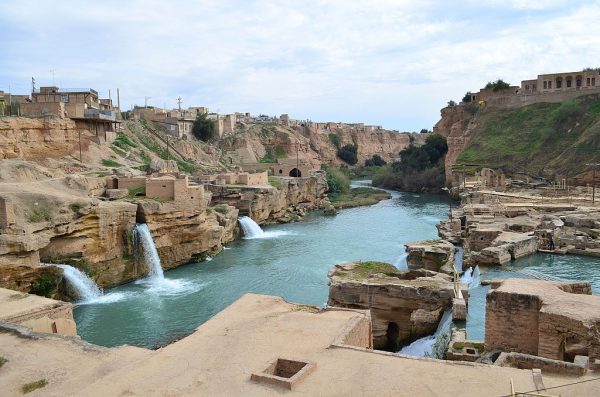 You will also visit another UNESCO World Heritage site, the Shushtar, Historical Hydraulic System, inscribed as a masterpiece of creative genius and which can be traced back to Darius the Great in the 5th century B.C.
You will also visit another UNESCO World Heritage site, the Shushtar, Historical Hydraulic System, inscribed as a masterpiece of creative genius and which can be traced back to Darius the Great in the 5th century B.C.  Overnight at 5-star Pars Hotel in Ahwaz.
Overnight at 5-star Pars Hotel in Ahwaz.
Day 5 – Ahwaz – Dorud by Rail At 10:25 AM be at the Ahwaz station to board the train for Dorud.  This rail trip has been described by some experienced train travelers as follows: “The train ride between Dorud and Andimeshk is one of the most beautiful anywhere. The train passes through rocky canyons and river valleys, periodically stopping at tiny villages of literally 10 buildings or fewer. It was one of the highlights of our travels in Iran, and must be one of the most scenic train journeys in the world.”
This rail trip has been described by some experienced train travelers as follows: “The train ride between Dorud and Andimeshk is one of the most beautiful anywhere. The train passes through rocky canyons and river valleys, periodically stopping at tiny villages of literally 10 buildings or fewer. It was one of the highlights of our travels in Iran, and must be one of the most scenic train journeys in the world.”  From there travel on to Borujerd where you will overnight at the top hotel in town, the Zagros Hotel, which is described in Lonely Planet as “a local tourist attraction in itself.”
From there travel on to Borujerd where you will overnight at the top hotel in town, the Zagros Hotel, which is described in Lonely Planet as “a local tourist attraction in itself.”
Day 6 – Kangavar After breakfast drive to Kangavar to visit the ancient Anahita Temple, said to date back to the Second Century BC.  From there drive on to the UNESCO World Heritage site of Bisotun, where remarkable bas-relief figures of the Emperor Darius are carved into a cliff side.
From there drive on to the UNESCO World Heritage site of Bisotun, where remarkable bas-relief figures of the Emperor Darius are carved into a cliff side. 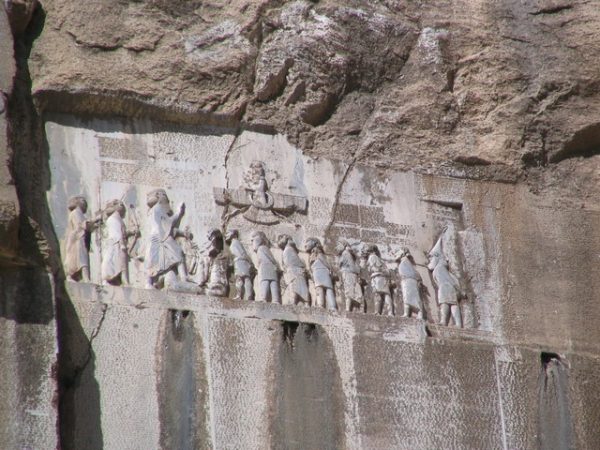 There is one more important site to visit today, one that has been proposed for a UNESCO World Heritage status: Taq-e Bostan.
There is one more important site to visit today, one that has been proposed for a UNESCO World Heritage status: Taq-e Bostan. 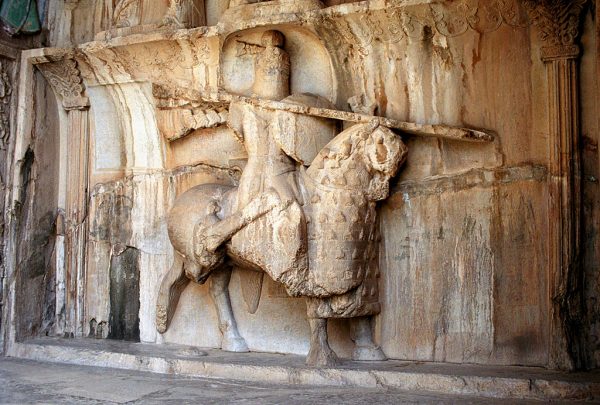 The Taq-e Bostan is a series of large rock bas-reliefs dating from the Sassanid Empire of Persia, the Iranian dynasty which ruled western Asia from 226 to 650 AD. This site is located in the heart of the Zagros Mountains, where it has withstood almost 1,700 years of wind and rain. Overnight in Kermanshah.
The Taq-e Bostan is a series of large rock bas-reliefs dating from the Sassanid Empire of Persia, the Iranian dynasty which ruled western Asia from 226 to 650 AD. This site is located in the heart of the Zagros Mountains, where it has withstood almost 1,700 years of wind and rain. Overnight in Kermanshah.
Day 7 – Kermanshah to Hamadan by Road Before leaving Kermanshah in the morning visit the Hosseinieh, a Muslim religious complex with especially striking tile work.  Then drive to the ancient city of Hamadan. After checking into your hotel, visit the tomb of Esther and her uncle Mordechai.
Then drive to the ancient city of Hamadan. After checking into your hotel, visit the tomb of Esther and her uncle Mordechai. 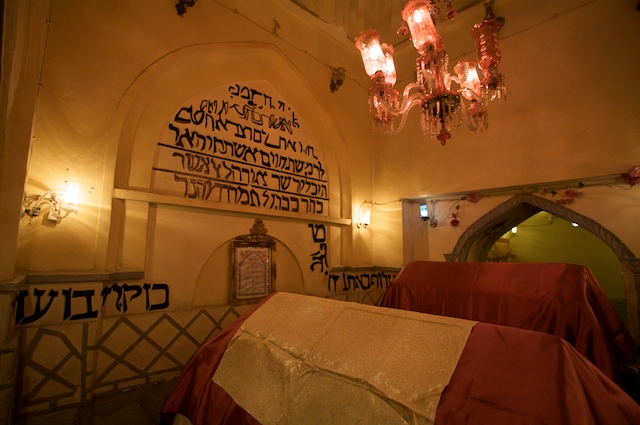 According to the Old Testament, Esther was the wife of Xerxes (the Biblical King Ahasuerus) who saved the Jews from the evil Haman. If you happen to think of it, the Rabbi/custodian of the tomb is a great collector of foreign fountain pens and appreciates any addition to his collection.
According to the Old Testament, Esther was the wife of Xerxes (the Biblical King Ahasuerus) who saved the Jews from the evil Haman. If you happen to think of it, the Rabbi/custodian of the tomb is a great collector of foreign fountain pens and appreciates any addition to his collection.
….
 You will also visit Hegmataneh Hill, where there are recent excavations from the ancient Median and Achaemenid dynasties.
You will also visit Hegmataneh Hill, where there are recent excavations from the ancient Median and Achaemenid dynasties.  Also around Hamadan, in the mountains above the city, is Ganjnameh, the site of ancient cuneiform rock carvings, dating from the time of King Xerxes in the 5th Century BC. Overnight at a 4-star hotel.
Also around Hamadan, in the mountains above the city, is Ganjnameh, the site of ancient cuneiform rock carvings, dating from the time of King Xerxes in the 5th Century BC. Overnight at a 4-star hotel.
Day 8 – Hamadan to Isfahan by Road  Driving from Hamadan to Isfahan, around 250 miles away, there will be a stop in Khoramabad to visit the spectacular Falak-ol-Aflak castle, which is among the most important structures built during the Sassanid era, over 1800 years ago. Then continue on to Isfahan. For many tourists Isfahan is the high point of their trip. It can be called the tourist center of Iran and you are likely to run into many other foreign groups there.
Driving from Hamadan to Isfahan, around 250 miles away, there will be a stop in Khoramabad to visit the spectacular Falak-ol-Aflak castle, which is among the most important structures built during the Sassanid era, over 1800 years ago. Then continue on to Isfahan. For many tourists Isfahan is the high point of their trip. It can be called the tourist center of Iran and you are likely to run into many other foreign groups there.
Overnight at the famous Abbasi Hotel, built on the site of a royal caravanserai.
….
Isfahan is justly famous for its 11 bridges spanning the Zayandeh River (although the presence of water in the river is seasonal as you can see in one of the shots above). These bridges are beautiful architectural feats, each one being distinctive and impressive in its own right. You will be able to visit several of these unique bridges and can walk across some of them.  You will be still staying overnight in Isfahan at the 5-star hotel Abbasi Hotel.
You will be still staying overnight in Isfahan at the 5-star hotel Abbasi Hotel.
….
Isfahan boasts two UNESCO World Heritage sites: Meidan Emam Square & the Jameh Mosque. 
….
 You may have already seen photos of the Meidan Emam. The Meidan was built by Shah Abbas I the Great at the beginning of the 17th century, and it is bordered on all sides by monumental buildings linked by a series of two-story arcades. The site is known for the Royal Mosque, the Mosque of Sheykh Lotfollah, the magnificent Portico of Qaysariyyeh and the 1Sth-century Timurid palace. They are an impressive testimony to the level of social and cultural life in Persia during the Safavid era. There will be plenty of time to walk around the square, visit some of the adjoining buildings and the great mosque and explore the nearby bazaar. The bazaar itself is huge and you may well find some things to purchase, even carpets (see Q. & A. on buying carpets in Iran).
You may have already seen photos of the Meidan Emam. The Meidan was built by Shah Abbas I the Great at the beginning of the 17th century, and it is bordered on all sides by monumental buildings linked by a series of two-story arcades. The site is known for the Royal Mosque, the Mosque of Sheykh Lotfollah, the magnificent Portico of Qaysariyyeh and the 1Sth-century Timurid palace. They are an impressive testimony to the level of social and cultural life in Persia during the Safavid era. There will be plenty of time to walk around the square, visit some of the adjoining buildings and the great mosque and explore the nearby bazaar. The bazaar itself is huge and you may well find some things to purchase, even carpets (see Q. & A. on buying carpets in Iran).
….
The second UNESCO site is the Jameh Mosque. Located in the historic center of Isfahan, the Masjed-e Jim (“Friday mosque”™) can be seen as a stunning illustration of the evolution of mosque architecture over twelve centuries, starting in AD 841. This is the oldest preserved edifice of its type in Iran and a prototype for later mosque designs throughout Central Asia. The complex, covering more than 20,000 m, is also the first Islamic building that adapted the four courtyard layout of Sassanid palaces to Islamic religious architecture. Its double-shelled ribbed domes represent an architectural innovation that inspired builders throughout the region. The site also features remarkable decorative details representative of stylistic developments over more than a thousand years of Islamic art.  It may even be possible for you to meet with some Muslim clerics who speak English and are interested in discussions with Americans. You may not always agree with what they have to say, but it is guaranteed to be an interesting discussion.
It may even be possible for you to meet with some Muslim clerics who speak English and are interested in discussions with Americans. You may not always agree with what they have to say, but it is guaranteed to be an interesting discussion.
….
Another place well worth visiting in Isfahan is the Vank Cathedral, established by Armenian immigrants after the Ottoman War of 1603 -1605. The church has beautifully detailed wall paintings which retell Biblical stories. There is also an Armenian museum at the site. The neighborhood around the Vank Cathedral has become somewhat “trendy”and is an interesting area to walk around and have dinner. These are only some of the highlights of Isfahan. There is a lot more to see and how much you see depends on how early a start you get in the morning. Your guide and driver will leave as early as you like and together you can decide on your next day’s itinerary. Overnight Isfahan at the 5-star Abbasi Hotel again.
Day 11 – Isfahan to Shiraz by Road In the morning head south to another very important Iranian tourist center, Shiraz. Shiraz will be your base for visiting three famous UNESCO World Heritage sites: Persepolis, Pasargadae and Naghsh-e- Rostam. All three of these sites are within easy driving distance of Shiraz and the day-long tour to explore them will be a major activity on this part of the tour. 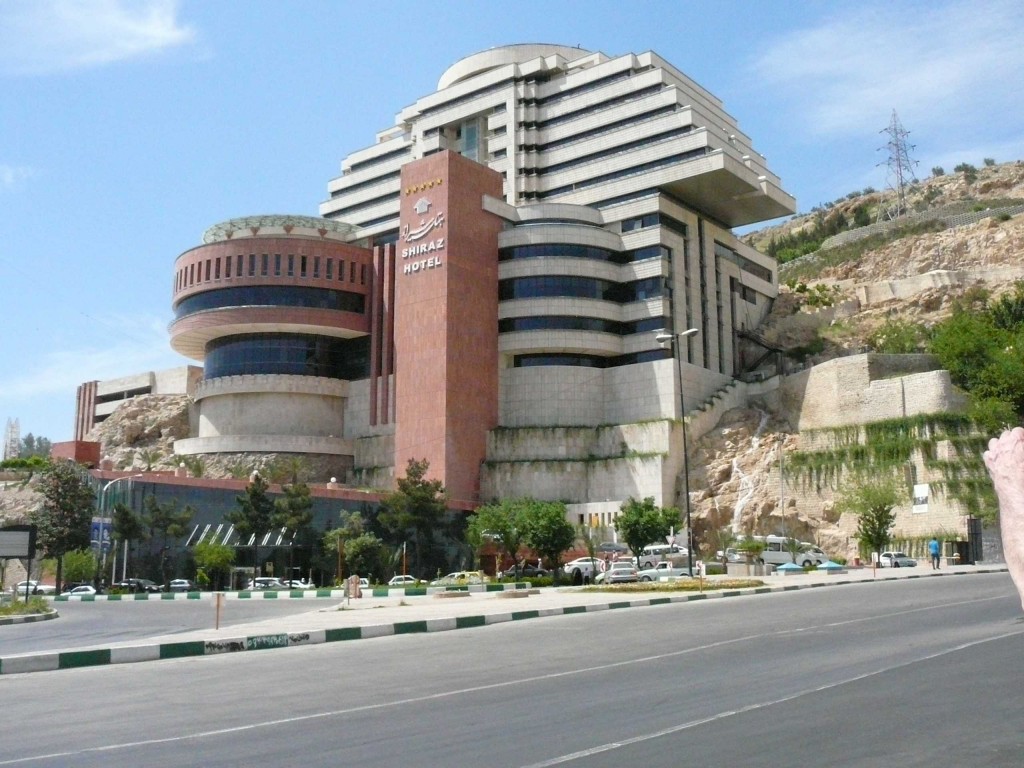 Overnight Shiraz at the 5-star Grand Hotel Shiraz, a sensational and luxurious hotel built into the side of a cliff.
Overnight Shiraz at the 5-star Grand Hotel Shiraz, a sensational and luxurious hotel built into the side of a cliff.
Day 12 – Shiraz After a good buffet breakfast, prepare for your excursion to Persepolis. This day-long tour will encompass three major sites around Shiraz.  Persepolis is probably the most famous single historical site in lran and a UNESCO World Heritage Site as well. When it was founded by Darius III in 518 BC, Persepolis was the capital of the Achaemenid Empire, where the king of kings created an impressive palace complex inspired by Mesopotamian models. The importance and quality of the monumental ruins make it a unique archaeological site.
Persepolis is probably the most famous single historical site in lran and a UNESCO World Heritage Site as well. When it was founded by Darius III in 518 BC, Persepolis was the capital of the Achaemenid Empire, where the king of kings created an impressive palace complex inspired by Mesopotamian models. The importance and quality of the monumental ruins make it a unique archaeological site. 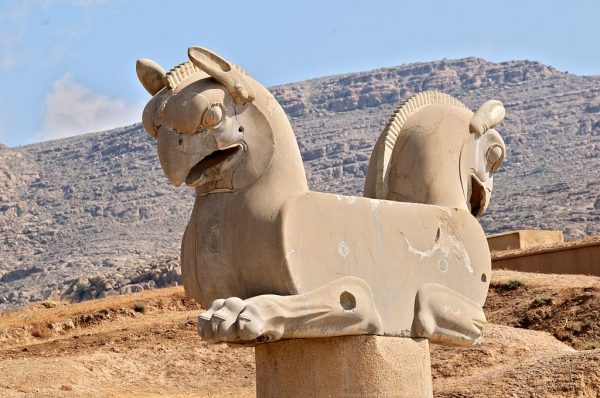 Persepolis was the example par excellence of the dynastic city, the symbol of the Achaemenid dynasty, which is why it was burned by the Greeks of Alexander the Great in 330 BC. According to Plutarch, they carried away its treasures on 20,000 mules and 5,000 camels.
Persepolis was the example par excellence of the dynastic city, the symbol of the Achaemenid dynasty, which is why it was burned by the Greeks of Alexander the Great in 330 BC. According to Plutarch, they carried away its treasures on 20,000 mules and 5,000 camels.  What remains today, dominating the city, is the immense stone terrace (530 m by 330 m), half-natural, half-artificial, backed against the mountains. As in Mesopotamia, the principal building material was sun-dried brick; much of which, has happily survived the vicissitudes of time. Pasargadae
What remains today, dominating the city, is the immense stone terrace (530 m by 330 m), half-natural, half-artificial, backed against the mountains. As in Mesopotamia, the principal building material was sun-dried brick; much of which, has happily survived the vicissitudes of time. Pasargadae 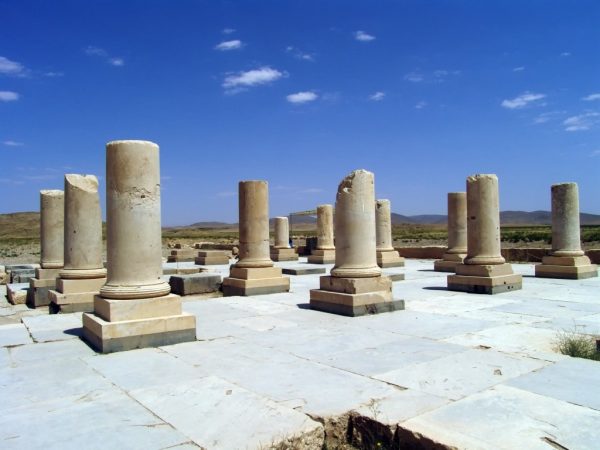 Still another UNESCO World Heritage Site, Pasargadae was the first dynastic capital of the Achaemenid Empire, founded by Cyrus ll the Great in the 6th century BC. Its palaces, gardens and the mausoleum of Cyrus are outstanding examples of the first phase of royal Achaemenid art and architecture and exceptional testimonies of Persian civilization.
Still another UNESCO World Heritage Site, Pasargadae was the first dynastic capital of the Achaemenid Empire, founded by Cyrus ll the Great in the 6th century BC. Its palaces, gardens and the mausoleum of Cyrus are outstanding examples of the first phase of royal Achaemenid art and architecture and exceptional testimonies of Persian civilization.  Particularly noteworthy vestiges include: the Mausoleum of Cyrus II; Tall-e Takht, a fortified terrace; and a royal ensemble of gatehouse, audience hall, residential palace and gardens. Pasargadae was the capital of the first great multicultural empire in Western Asia. Spanning the Eastern Mediterranean and Egypt to the Hindus River, it is considered to be the first empire that respected the cultural diversity of its different peoples. This was reflected in Achaemenid architecture, a synthetic representation of different cultures. (It is possible that Pasargadae will be visited on the next day, on your way to Yazd.) Naghsh-e-Rostam
Particularly noteworthy vestiges include: the Mausoleum of Cyrus II; Tall-e Takht, a fortified terrace; and a royal ensemble of gatehouse, audience hall, residential palace and gardens. Pasargadae was the capital of the first great multicultural empire in Western Asia. Spanning the Eastern Mediterranean and Egypt to the Hindus River, it is considered to be the first empire that respected the cultural diversity of its different peoples. This was reflected in Achaemenid architecture, a synthetic representation of different cultures. (It is possible that Pasargadae will be visited on the next day, on your way to Yazd.) Naghsh-e-Rostam
This is one of our favorite sites in Iran, although perhaps not as famous as the two described above. You will see four tombs belonging to Achaemenid kings carved out of the rock face at a considerable height above the ground. They are somewhat reminiscent of Petra in Jordan, but much, much easier to get to.  The tombs are known locally as the ‘Persian crosses’ after the shape of the facades of the tombs. In addition, there are seven over-life-sized rock reliefs at the site, depicting monarchs of the Sassanid period. It is believed that they were created to celebrate a great victory of ancient times. Overnight in Shiraz at the Grand Hotel.
The tombs are known locally as the ‘Persian crosses’ after the shape of the facades of the tombs. In addition, there are seven over-life-sized rock reliefs at the site, depicting monarchs of the Sassanid period. It is believed that they were created to celebrate a great victory of ancient times. Overnight in Shiraz at the Grand Hotel.
Day 13 Shiraz to Yazd by Road In the morning, before setting out for Yazd you will have time to visit some of the interesting places within Shiraz itself. It will be a good idea to get an early start in the morning in order to see as much as possible.  Among the places to see are Karim Khan complex, resembling a medieval fortress; the mausoleum of the 8th-century poet Hafez and the main bazaar.
Among the places to see are Karim Khan complex, resembling a medieval fortress; the mausoleum of the 8th-century poet Hafez and the main bazaar.
You will also have the opportunity to visit the Eram Garden. Established in the 11th century, the Eram Garden is a series of historic Persian gardens and as a whole, have been designated a UNESCO World Heritage site.
Day 14 – Yazd 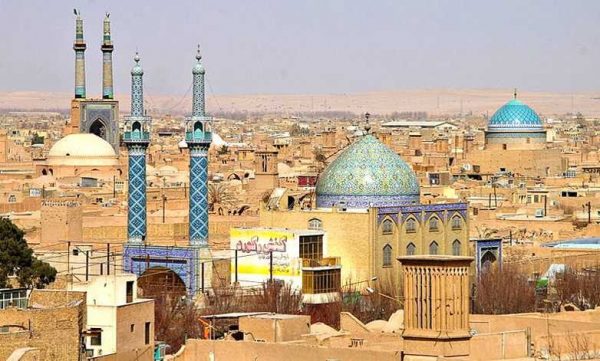 According to UNESCO, Yazd is one of the oldest continually inhabited cities in the world and is like a living museum. In the morning, after breakfast, begin your tour of the fascinating city of Yazd.
According to UNESCO, Yazd is one of the oldest continually inhabited cities in the world and is like a living museum. In the morning, after breakfast, begin your tour of the fascinating city of Yazd.  Among the first things you notice are the many wind-catchers (badgirs) perched on the rooftops of many buildings. The wind-catchers were an ancient form of air conditioning and Yazd is famous for having so many examples of them. Your guide will explain how they work. You can take a stroll through the old city of Yazd, made up of a labyrinth of narrow, winding alleys, where without a guide, it might be easy to get lost.
Among the first things you notice are the many wind-catchers (badgirs) perched on the rooftops of many buildings. The wind-catchers were an ancient form of air conditioning and Yazd is famous for having so many examples of them. Your guide will explain how they work. You can take a stroll through the old city of Yazd, made up of a labyrinth of narrow, winding alleys, where without a guide, it might be easy to get lost.  Yazd was known as a center of Zoroastrianism (there are still around 150,000 Zoroastrians living in lran today). The Towers of Silence, on the edge of the city, were used to expose bodies to the elements until the 1960s, when the practice was banned by the Shah.
Yazd was known as a center of Zoroastrianism (there are still around 150,000 Zoroastrians living in lran today). The Towers of Silence, on the edge of the city, were used to expose bodies to the elements until the 1960s, when the practice was banned by the Shah.  You can climb up the large hills where the towers can be seen and you can also enter the ancient houses where members of the funeral parties stayed. Even in the surrounding heat, these houses are amazingly cool. Yazd is also a place where you can learn about the fascinating ‘qanat’ water system, an ancient method of supplying water to cities and farms by means of underground channels. There is even a water museum!
You can climb up the large hills where the towers can be seen and you can also enter the ancient houses where members of the funeral parties stayed. Even in the surrounding heat, these houses are amazingly cool. Yazd is also a place where you can learn about the fascinating ‘qanat’ water system, an ancient method of supplying water to cities and farms by means of underground channels. There is even a water museum!  One of the most exciting things you can do in Yazd is to see the body building men (see photo above) who show up twice an evening at the Zurkhane or House of Strength. This is an ancient martial arts ritual, accompanied by music and lasting an hour, that is open to the public. It is in the same building that houses an ancient reservoir that you can visit first. The men easily twirl 20-kilo pins or clubs as part of their exercises.
One of the most exciting things you can do in Yazd is to see the body building men (see photo above) who show up twice an evening at the Zurkhane or House of Strength. This is an ancient martial arts ritual, accompanied by music and lasting an hour, that is open to the public. It is in the same building that houses an ancient reservoir that you can visit first. The men easily twirl 20-kilo pins or clubs as part of their exercises. Overnight in Yazd at the Dad Hotel.
Overnight in Yazd at the Dad Hotel.
Day 15 – Yazd to Tehran by Rail In the morning you can continue your tour of Yazd, taking in what you did not have time to see the day before. Then it will be time to head for the railroad station to board the 14:20 train for the overnight trip to Tehran. Arrival is at 7 AM the next morning. Transfer to the Espinas Hotel. If you’re not tired you can tour more of Tehran before it is time to head to the international airport for your flight home.
















